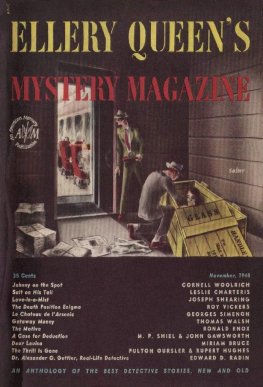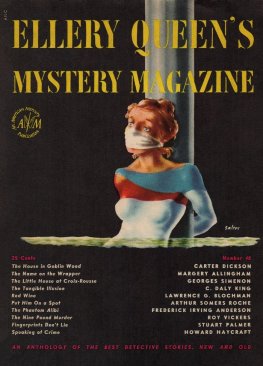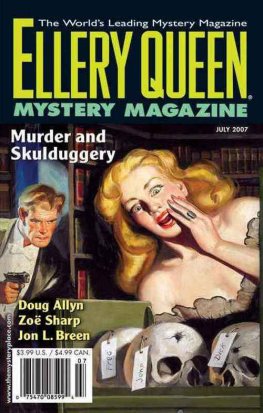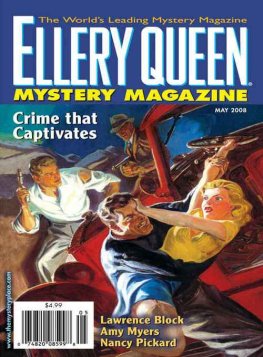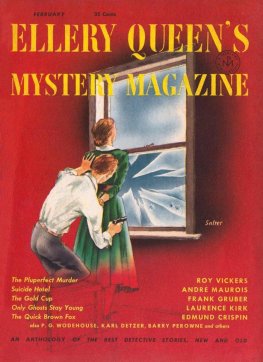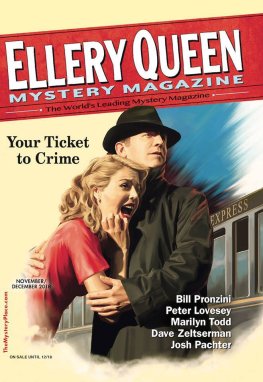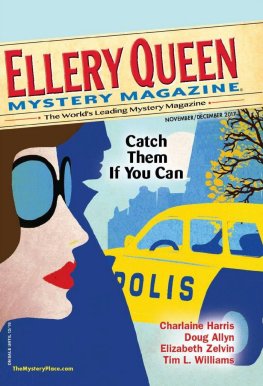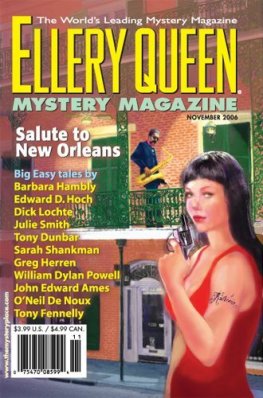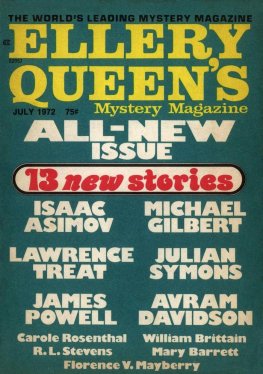Miriam Bruce - Ellery Queen’s Mystery Magazine. Vol. 12, No. 60, November 1948
Here you can read online Miriam Bruce - Ellery Queen’s Mystery Magazine. Vol. 12, No. 60, November 1948 full text of the book (entire story) in english for free. Download pdf and epub, get meaning, cover and reviews about this ebook. City: Mew York, year: 1948, publisher: The American Mercury, genre: Detective and thriller. Description of the work, (preface) as well as reviews are available. Best literature library LitArk.com created for fans of good reading and offers a wide selection of genres:
Romance novel
Science fiction
Adventure
Detective
Science
History
Home and family
Prose
Art
Politics
Computer
Non-fiction
Religion
Business
Children
Humor
Choose a favorite category and find really read worthwhile books. Enjoy immersion in the world of imagination, feel the emotions of the characters or learn something new for yourself, make an fascinating discovery.
- Book:Ellery Queen’s Mystery Magazine. Vol. 12, No. 60, November 1948
- Author:
- Publisher:The American Mercury
- Genre:
- Year:1948
- City:Mew York
- Rating:3 / 5
- Favourites:Add to favourites
- Your mark:
- 60
- 1
- 2
- 3
- 4
- 5
Ellery Queen’s Mystery Magazine. Vol. 12, No. 60, November 1948: summary, description and annotation
We offer to read an annotation, description, summary or preface (depends on what the author of the book "Ellery Queen’s Mystery Magazine. Vol. 12, No. 60, November 1948" wrote himself). If you haven't found the necessary information about the book — write in the comments, we will try to find it.
Miriam Bruce: author's other books
Who wrote Ellery Queen’s Mystery Magazine. Vol. 12, No. 60, November 1948? Find out the surname, the name of the author of the book and a list of all author's works by series.
Ellery Queen’s Mystery Magazine. Vol. 12, No. 60, November 1948 — read online for free the complete book (whole text) full work
Below is the text of the book, divided by pages. System saving the place of the last page read, allows you to conveniently read the book "Ellery Queen’s Mystery Magazine. Vol. 12, No. 60, November 1948" online for free, without having to search again every time where you left off. Put a bookmark, and you can go to the page where you finished reading at any time.
Font size:
Interval:
Bookmark:
Ellery Queens Mystery Magazine. Vol. 12, No. 60, November 1948

The Death Position Enigma
by Roy Vickers
Roy Vickers has two significant detective-story creations to his everlasting credit. The wore important of the two is the Department of Dead Ends, that fascinating bureau of Scotland Yard which has proved Mr. Vickers to be the most brilliant contemporary manipulator of the inverted. detective story. The lesser conception is that of ethereal, saint faced Fidelity Dove, one of the most accomplished lady larcenists in the fictional history of crime... At the time we published THE DETECTIVE SHORT STORY: A BIBLIOGRAPHY (1942), we thought we had a first edition of THE EXPLOITS OF FIDELITY DOVE. As a matter of fact, we had in our collection two copies of this very scarce book, one bound in gray cloth and the second, identical in all other respects, bound in light blue cloth. On the basis of these two variants we listed the first edition as published in 1935 by George Newnes of London. There was nothing about either copy of the book that made us even remotely suspicious they both seemed like genuine first editions. But recently we discovered a book which confirmed for the umpteenth time the utter fallibility of bibliographic data and research.
From one of our London bookscouts came an orange-cloth book clearly titled THE EXPLOITS OF FIDELITY DOVE. The volume contained twelve tales exactly the same in number, sequence, titles, and text as the dozen stories in our gray and light-blue books of the same name. Now, however, there was one highly suspicious difference: the orange cloth was much superior in quality to the gray and light-blue cloth of the other copies and better quality binding invariably suggests the true first edition. Moreover and this is the astonishing revelation the orange-bound volume was credited to an author by the name of David Durham!
A transatlantic checkup through our bookscout added further mystery: the British Museum of London had a record of the Durham book but it had no record that David Durham and Roy Vickers are one and the same person! The Durham book, however, was deposited for copyright at the British Museum in 1924 eleven years prior to the volume signed as by Roy Vickers, thus establishing beyond doubt that the Roy Vickers edition was merely a reprint. Needless to add, our original bibliographic entry on Fidelity Dove was completely inaccurate.
Now, irrelevantly, read The Death Position Enigma, the newest Department of Dead Ends story by Roy Vickers, alias David Durham. The Death Position Enigma is another excellent example of Roy Vickerss continuing mastery in the art of writing the inverted detective story.
Arnold Habershon, chartered accountant, was the kind of man you would never notice a fussy little man, the slave of his own routine. When he dressed in the morning, he unconsciously timed his movements to those of the service maid, who was as regular as himself in her habits. He adjusted his tie as the maid left the flat. He knew that his breakfast would be waiting, and that on the table would be The Times and The Daily Record.
It was a largish flat for a man living by himself. Spare bedroom, never used, sitting-room, and dining-room.
From the doorway of the dining-room he could glimpse the headlines of The Record a glimpse that ended his uncertainty. As usual, he turned and shut the door. Only, on this particular Monday morning, he took longer over it than usual.
In that paper, ran his unspoken thought, I shall probably find that I have made the traditional mistake that leads to the gallows. It will not be possible to take evasive action. It will be possible only to preserve ones dignity.
When a respectable citizen of mild habits commits murder, his reactions are inevitably different from those of the crook who kill in the course of business. Remorse, however, is rare. Habershons sense of sin was transferred to Webber, his victim for wantonly thrusting Habershon into the horror of committing murder. Such precautions as he had taken against discovery had been inspired less by fear than by a sort of moral duty to himself. If the precautions should fail again, the blame must be laid at the door of the unspeakable Webber.
HOUSEHOLDER SHOT DEAD, proclaimed The Record. DEATH POSITION ENIGMA.
Death position enigma! These fellers yell themselves into sheer meaninglessness! snorted Habershon, and turned in disgust to The Times, where he found only a five-line paragraph. The Record carried two columns. Habershon read, at first with resignation, then with astonishment.
That isnt an enigma its an absurdity and a lie as well! he exclaimed aloud.
He read on with the growing suspicion that someone else must have entered after he had left.
The murderer made entry by the window and left by the front door, as indicated by one-way footprints on the flower bed (photo back page) and soil trodden into the sitting-room carpet.
But I didnt enter by the window... Oh yes, I did! When I went back.
In a mess of sensational verbiage, The Record had smothered a clear-cut account. On Sunday morning, a telephone linesman had called the police to Webbers brick-built bungalow, which stood by itself on the fringe of an Essex village. A car, not that of the deceased, had left double tire tracks in the garden, from which footprints led to the window of the sitting-room. The dead man was found sitting at his writing table. The position was so unusual that the photographs taken by the police were even more descriptive than the report, more credible than the actuality.
The photographs showed a bulky man, apparently alive, leaning forward in a natural position, his left hand holding the telephone receiver to his ear, the left elbow resting on the table. The right hand was clenched, the thumb extended downwards the right arm suspended exactly nine and one-half inches above the writing table.
Thus the illusion was complete of a man interrupted in a telephone conversation by the entry of a friend. While continuing to speak on the telephone the man signals to his friend that some joint hope has been frustrated. Or he might have been indicating some fiat object on the table. Whatever it was, the fist and the extended thumb gave an impression of great urgency.
Called on the Sunday morning, Detective Inspector Karslake certainly regarded the position of the corpse as an enigma. It made sense only if one could imagine that Webber had been suddenly frozen to death, whereas in fact he had been killed by a pistol shot. The body of a man who has been shot did not, he knew, behave as if the man had been suddenly frozen to death. The pose was so lifelike one waited for the thumb to come down on the table! It was like one of those statues of arrested motion the horse with one hoof perpetually poised.
We dont know yet whether he ever said anything on that telephone, Doctor, said Karslake. But we know that he lifted the receiver at around nine-thirty on Saturday night. As the receiver was not replaced, the girl sounded the buzzer but got no answer. In the morning a linesman came here and when he saw that called the local police. Karslake glared at the corpse as if it were a personal insult. Have you ever seen anything like it, Doctor?
Not exactly like it. But youve seen freak effects yourself caused by rigor mortis.
But it isnt a freak effect! He was doing something. Telephoning and look at that thumb! If he wasnt saying thumbs down to someone, he was jamming it hard on a bell-push or something. And theres no bell-push. And there was no one in the house to answer a bell, and theres no wire from this room anyway.
Font size:
Interval:
Bookmark:
Similar books «Ellery Queen’s Mystery Magazine. Vol. 12, No. 60, November 1948»
Look at similar books to Ellery Queen’s Mystery Magazine. Vol. 12, No. 60, November 1948. We have selected literature similar in name and meaning in the hope of providing readers with more options to find new, interesting, not yet read works.
Discussion, reviews of the book Ellery Queen’s Mystery Magazine. Vol. 12, No. 60, November 1948 and just readers' own opinions. Leave your comments, write what you think about the work, its meaning or the main characters. Specify what exactly you liked and what you didn't like, and why you think so.

